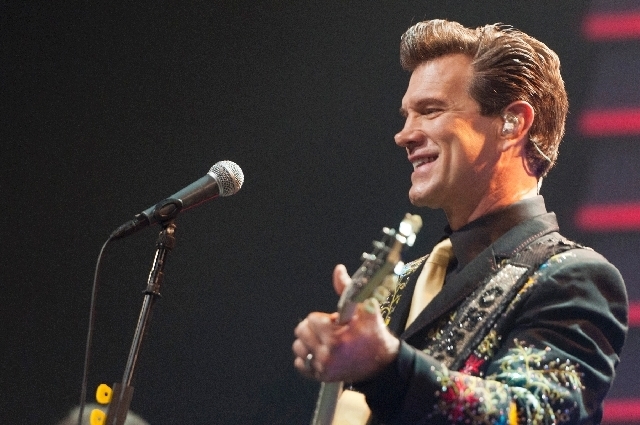Chris Isaak bringing his game to Smith Center
Chris Isaak may be a Vegas kind of guy. But not necessarily the kind of Vegas guy you think.
Sure, the retro-minded rocker recorded several Elvis Presley tunes on his most recent album, “Beyond the Sun” — some of which he’ll undoubtedly perform at Wednesday’s Smith Center concert.
But Isaak and his bandmates will be attired in stage outfits that make them “look like something that escaped from the Liberace Museum,” he says.
As for the Elvis-Vegas connection, “it’s a town Elvis played in — but it’s Wayne’s town,” Isaak adds.
And if you need to ask “Wayne Who?” — well, you’re obviously not the Vegas type.
“When you think about Mr. Vegas, who is it?” Isaak says rhetorically, noting that he’s visited Wayne Newton at his longtime former abode, Casa de Shenandoah, and has joined Newton on USO tours.
“I like hanging out with Wayne,” Isaak says. “He’s got a million good stories” to share.
“He couldn’t be a nicer guy,” Isaak says of Newton during a telephone interview at a recent tour stop in Phoenix. “And what are the chances of being down-to-earth and nice and in showbiz your whole life?”
Maybe Isaak hasn’t been in showbiz his whole life, but he’s definitely got the nice and down-to-earth down pat.
Especially when he considers the one thing missing from this current tour: longtime drummer Kenney Dale Johnson, who’s undergoing treatment for leukemia and isn’t expected back until October.
Silvertone (which shares its name with guitars, record players and other musical equipment sold by Sears through the early ’70s) has been Isaak’s backing band “since the Dead Sea was sick,” he says, only partially in jest.
“All of a sudden, your priorities get shook up,” Isaak says of Johnson’s illness.
“Most of my problems are” of the “I want the red one” variety, he admits. “But when Kenney got sick, I said, ‘I don’t care how the record’s doing — just please make my drummer healthy.’ ”
On Isaak’s current tour, veteran session drummer Curt Bisquera — who’s worked with everyone from Johnny Cash to Mick Jagger, Elton John to Celine Dion — joins Silvertone stalwarts such as bass player Rowland Salley and guitarist Hershel Yatovitz , who (along with Johnson) played themselves on Isaak’s Showtime sitcom “The Chris Isaak Show.”
Being the newbie, Bisquera doesn’t always know where Isaak’s going, when “sometimes I just throw stuff in,” the singer says of his nonexistent set list. “I think, ‘Kenney knows all these, but Curt doesn’t.’ ”
But Bisquera “does great,” Isaak adds.
That holds true whether the song is one of Isaak’s own lovelorn hits — “Wicked Game,” say, or “Somebody’s Crying” — or a loving “Beyond the Sun” cover of a classic by Presley, Cash, Roy Orbison or Carl Perkins.
Many of the songs on “Beyond the Sun” are versions of the songs Isaak heard as a kid, listening to his parents’ 45s on their second hand stereo. (It “was one of those old-fashioned ones that looked like a suitcase and folded out,” Isaak writes in his “Beyond the Sun” liner notes. “We thought it sounded fantastic, and scratchy sound or not, the records moved you.”)
Little wonder, then, that when it came time to record “Beyond the Sun,” Isaak and Silvertone headed straight to Memphis’ legendary Sun Records studio, where founder Sam Phillips recorded the originals. (Harrah’s “Million Dollar Quartet” dramatizes the 1956 day Presley, Cash, Perkins and Jerry Lee Lewis converged at the studio.)
Emulating 1950s recording methods, “we recorded all at one time, everyone together,” Isaak says, whether the tune was Presley’s, Orbison’s — or his own “Live It Up,” complete with jangling guitars, a propulsive beat and such lyrics as “You can live it up and love it up, but I won’t ever give you up.”
While at Sun, they received a bit of advice from guitarist Roland Janes , who played on numerous Sun recordings, including Lewis’.
Isaak asked him how loud they played — so he’d know how loud he’d have to sing — and James told them that, back in the day, “ ‘we played as loud as we wanted,’ ” before adding, “with a big smile, that it was 1956,” and what was loud then isn’t quite so loud now.
In Isaak’s view, that laid-back, light hearted approach helped recapture the spirit of those early rock ’n’ roll tunes, recorded by aspiring musicians who were thinking, “ ‘I was pickin’ cotton this morning and I’ll probably be pickin’ cotton tomorrow, but now I’m in here, making a record — and this is fun!’ ”
That explains why “you can hear the happiness and freedom” in the music, he adds.
Unlike “today,” when “every album people make” seems calculated, he says, rock’s pioneers never equated making a recording with “a career move.”
Little wonder Isaak “liked rock ’n’ roll when it was a little less cluttered.”
His music reflects that approach — and his desire to “have fun making music.”
After all, “if I make myself happy, if I’m having a good time, that’s the best way to have other people share” those good times — in the recording studio or on a concert stage.
“Onstage, you don’t have to be as intense,” he says.
But you do have to be on, Isaak cautions.
“We don’t just stand there and stare at our shoes,” he says. “We’re the last of the runnin’, jumpin’, tumblin’ ” rockers.
Contact reporter Carol Cling at ccling@
reviewjournal.com or 702-383-0272.
Preview
Chris Isaak
7:30 p.m. Wednesday
Reynolds Hall, The Smith Center for the Performing Arts, 361 Symphony Park Ave.
$29-$89 (702-749-2000; www.thesmithcenter.com)






















